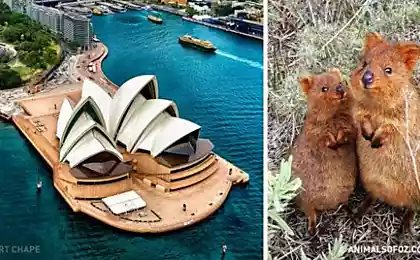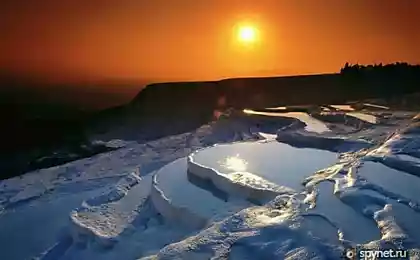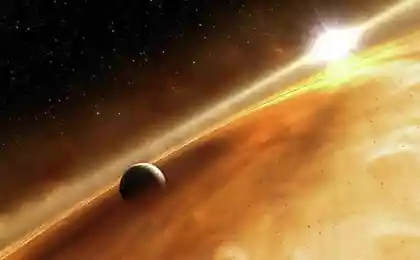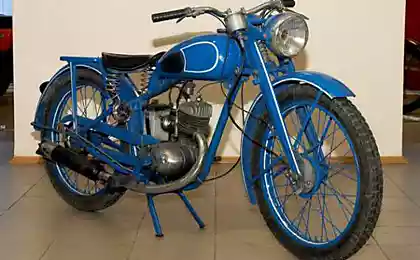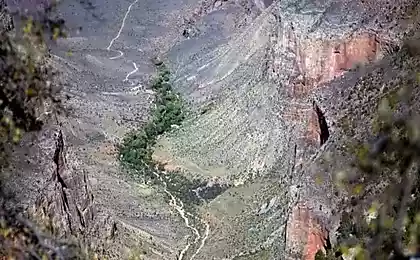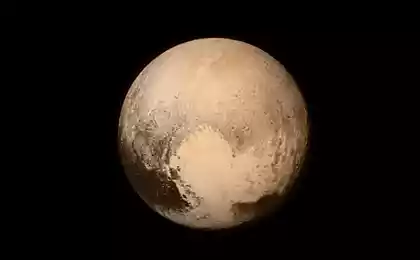221
Wonders of Nature: The Great Barrier Reef
Along the tropical coast of Australia for more than 2900 km stretches the greatest creation of nature – the Great Barrier Reef. The world’s largest coral system is the largest living structure on the planet. It includes nearly 3,000 different reefs and more than 900 islands dotting the sloping lagoon. The area covered by the stone sea giant is 344,400 square kilometers. There is a natural wonder in the Coral Sea, almost parallel to the coast of Queensland, Australia.
The Great Barrier Reef stretches from south to north, originating at the Tropic of Capricorn, located between the cities of Bandaberg and Gladstone, and ending in the Torres Strait, which separates Australia from New Guinea. In the northern part, near Cape Melville, the coral complex is only 32-50 km from the coast, and on the southern side it breaks up into small groups of reef formations, in some places moving away from the coastline for 300 km. It is the last mentioned places that attract a huge number of diving fans.
The size of the Great Barrier Reef is so huge that it can be seen from space. This fact is very impressive when you consider the size of the creatures that built the largest object ever created by living organisms. The system is made up of billions of small animals, usually no larger than a grain of rice, called coral polyps. Their appearance is like a tiny inverted jellyfish sitting in a stone bowl. They live together, colonies. Polyps cannot build reefs on their own, for this wise mother nature sent them helpers. Such in this case are millions of microscopic algae trapped in the tentacles of animals. They convert sunlight into energy food for corals. This symbiosis allows them to turn minerals into calcium carbonate and build their rocky skeletons. So each colony develops and grows, enriching the area with whole limestone massifs. However, their world is very vulnerable and fragile: even a slight increase in temperature - one degree - can cause the death of coral polyps.
Coral reefs occupy less than 1% of the oceans of the entire planet, but they are home to a quarter of all known marine life, and the Great Barrier Reef is their largest shelter. It is for this reason that in 1981 UNESCO included it in the list of World Heritage Sites, and CNN awarded the title of one of the Seven Wonders of the World.
The history of the reef has its roots from distant times. Hot Australia was not always in the tropical climate zone: for many millennia it was an integral part of Antarctica, and for most of history its coastal waters were too cold for the life of corals. The movement to the tropics took place about 65 million years ago, coinciding with a period of sea level rise, which created favorable conditions for the growth of coral polyps in the northeastern part of its coast.
The origin of the reef occurred about 25 million years ago due to the movement of the Australian lithospheric plate. The coast of the area, today called the state of Queensland, was flooded by tropical waters, as a result of which coral larvae brought by warm ocean currents were in these places and entrenched on the ground. Over time, the colonies began to grow and cover the seabed, over the millennia giving rise to the Great Barrier Reef as it can be seen today. So with the rise in the level of the World ocean at the same time there was an intensive growth of new layers. The history of the reef layers under the visible surface, which is constantly updated, dates back about 10 thousand years. The youngest sites, located on the peaks of older ones, were formed during the last 200 years and are at a depth of 15-20 meters.
For many hundreds of years, the Great Barrier Reef has attracted the attention of mankind: from ancient times to today, it has been used by the inhabitants of the Torres Islands and Australian Aborigines as an important component of the culture of local populations. However, Western civilization did not know about the existence of this natural monument for a long time.
Europeans learned about the grand living structure thanks to the famous navigator James Cook, who saw and realized the scale of this object in 1770. He literally came across a reef: one evening Cook heard the grinding of the bottom of the ship "Endeavor" on the underwater rock, as a result of which the ship suffered significant damage. Fortunately, the tide helped the situation to end safely - the ship was saved and the expedition continued.
The main part of the reef consists of more than 2900 individual reefs, the size of which varies from 0.01 km2 to 100 km2. Most of them are hidden under the water surface, and in order to view the coral “sculptures” in more detail, you will have to use diving equipment and dive into the warm Pacific waters. You can see the peaks of coral formations dissecting the water surface only during low tides. Between the coast and the Great Barrier Reef there is a rather shallow lagoon, the depth of which rarely exceeds 100 m.
The world’s largest ecosystem is famous not only for its huge variety of coral reefs, but also for its truly rich underwater world – there is hardly a place in the world that can compete with the Australian giant in the abundance of marine life. Thousands of different creatures found their home in this metropolis. Many of them are exquisitely beautiful, some seem to have come off the pages of a science fiction magazine, and some can bring death in the blink of an eye.
The diversity of life forms in the Great Barrier Reef for a long time will not give researchers peace, because to study all the underwater richness of its flora and fauna is not such an easy task. In its expanses, about 400 species of corals found their home, striking with an abundance of forms and species. Like a fabulous underwater garden, the entire territory of the Great Barrier Reef is full of bright colors of coral reefs of all colors of the rainbow. The most common colors are various shades of red, yellow, sometimes white, orange, brown, and occasionally even purple. Soft representatives of corals, which instead of a limestone skeleton in the tissues have solid crystal structures called sclerites, cover the “bodies” of their stony relatives.
The giant complex of coral reefs sheltered in its waters 1500 species of marine fish, of which about 500 species belong to the true reef, the most adapted to life in these conditions. Also, 30 species of whales, dolphins and porpoises, about 125 species of sharks and rays, 6 species of turtles, 14 species of sea snakes, about 5000 species of mollusks and 1300 species of crustaceans found their refuge here. Among the fish that live here is their largest representative - the whale shark. In addition, the reef sheltered in its expanses more than 200 species of birds.
Australia’s most famous natural attraction receives about two million visitors annually, bringing the region more than $ 3 billion in profits per year. In addition to the favorable impact on the economy of the country, this entails negative consequences that inevitably destroy the coral complex. The government has set a number of restrictions aimed at protecting the ecosystem, but human damage cannot be completely prevented. In addition, nature itself creates many dangers. These include the so-called fading, which very quickly leads to the death of corals, and in huge quantities. This phenomenon is caused by global warming, affecting water temperature. Another foe of the fragile balance of coral reefs is tropical hurricanes. But the status of the main enemy is the sea star "crown of thorns", the size of which can reach up to 50 cm. These echinoderm predators feed exclusively on coral polyps. The most devastating period of devastation due to the life of these pests occurred in the 80s of the last century.
According to a study conducted by the National Academy of Sciences in October 2012, since 1985, the reef has lost more than half of the coral polyps that make up its structure.
The main resort of the north of Australia, its most exotic corner and, as they say in the people, the main "gate" Great Barrier Reef - the city of Cairns provides its guests with the opportunity to spend the most intense rest in the arms of one of the wonders of the world. This area is famous for the fact that the coral islands are extremely close to the coast, and in just 1.5-2 hours of fast boat walking you can reach the famous dive points. In addition, it is convenient to make trips to nearby national parks, reserves, ancient villages and other equally colorful places.
The most fashionable resort islands are Hyman and Bedarra. Diving lovers will like the island of Magnetic, Heron and Lizard. And as for the resorts that combine diving, entertainment, excursions and upscale recreation, these are the islands of Hamilton, Keppel, Fraser, Dunk and Brampton.
Many documentaries have been made about this unique place of the planet, the most famous of them being BBC. Walking underwater. The Great Barrier Reef (1991) and the series created by the same Air Force in 2012, The Great Barrier Reef. Films, of course, will reveal the overall picture of the area, but in order to feel the grandeur of this miracle of nature, you need to see it firsthand.
Fish Napoleon:
Parrotfish:
Source:udivitelno.com
The Great Barrier Reef stretches from south to north, originating at the Tropic of Capricorn, located between the cities of Bandaberg and Gladstone, and ending in the Torres Strait, which separates Australia from New Guinea. In the northern part, near Cape Melville, the coral complex is only 32-50 km from the coast, and on the southern side it breaks up into small groups of reef formations, in some places moving away from the coastline for 300 km. It is the last mentioned places that attract a huge number of diving fans.
The size of the Great Barrier Reef is so huge that it can be seen from space. This fact is very impressive when you consider the size of the creatures that built the largest object ever created by living organisms. The system is made up of billions of small animals, usually no larger than a grain of rice, called coral polyps. Their appearance is like a tiny inverted jellyfish sitting in a stone bowl. They live together, colonies. Polyps cannot build reefs on their own, for this wise mother nature sent them helpers. Such in this case are millions of microscopic algae trapped in the tentacles of animals. They convert sunlight into energy food for corals. This symbiosis allows them to turn minerals into calcium carbonate and build their rocky skeletons. So each colony develops and grows, enriching the area with whole limestone massifs. However, their world is very vulnerable and fragile: even a slight increase in temperature - one degree - can cause the death of coral polyps.
Coral reefs occupy less than 1% of the oceans of the entire planet, but they are home to a quarter of all known marine life, and the Great Barrier Reef is their largest shelter. It is for this reason that in 1981 UNESCO included it in the list of World Heritage Sites, and CNN awarded the title of one of the Seven Wonders of the World.
The history of the reef has its roots from distant times. Hot Australia was not always in the tropical climate zone: for many millennia it was an integral part of Antarctica, and for most of history its coastal waters were too cold for the life of corals. The movement to the tropics took place about 65 million years ago, coinciding with a period of sea level rise, which created favorable conditions for the growth of coral polyps in the northeastern part of its coast.
The origin of the reef occurred about 25 million years ago due to the movement of the Australian lithospheric plate. The coast of the area, today called the state of Queensland, was flooded by tropical waters, as a result of which coral larvae brought by warm ocean currents were in these places and entrenched on the ground. Over time, the colonies began to grow and cover the seabed, over the millennia giving rise to the Great Barrier Reef as it can be seen today. So with the rise in the level of the World ocean at the same time there was an intensive growth of new layers. The history of the reef layers under the visible surface, which is constantly updated, dates back about 10 thousand years. The youngest sites, located on the peaks of older ones, were formed during the last 200 years and are at a depth of 15-20 meters.
For many hundreds of years, the Great Barrier Reef has attracted the attention of mankind: from ancient times to today, it has been used by the inhabitants of the Torres Islands and Australian Aborigines as an important component of the culture of local populations. However, Western civilization did not know about the existence of this natural monument for a long time.
Europeans learned about the grand living structure thanks to the famous navigator James Cook, who saw and realized the scale of this object in 1770. He literally came across a reef: one evening Cook heard the grinding of the bottom of the ship "Endeavor" on the underwater rock, as a result of which the ship suffered significant damage. Fortunately, the tide helped the situation to end safely - the ship was saved and the expedition continued.
The main part of the reef consists of more than 2900 individual reefs, the size of which varies from 0.01 km2 to 100 km2. Most of them are hidden under the water surface, and in order to view the coral “sculptures” in more detail, you will have to use diving equipment and dive into the warm Pacific waters. You can see the peaks of coral formations dissecting the water surface only during low tides. Between the coast and the Great Barrier Reef there is a rather shallow lagoon, the depth of which rarely exceeds 100 m.
The world’s largest ecosystem is famous not only for its huge variety of coral reefs, but also for its truly rich underwater world – there is hardly a place in the world that can compete with the Australian giant in the abundance of marine life. Thousands of different creatures found their home in this metropolis. Many of them are exquisitely beautiful, some seem to have come off the pages of a science fiction magazine, and some can bring death in the blink of an eye.
The diversity of life forms in the Great Barrier Reef for a long time will not give researchers peace, because to study all the underwater richness of its flora and fauna is not such an easy task. In its expanses, about 400 species of corals found their home, striking with an abundance of forms and species. Like a fabulous underwater garden, the entire territory of the Great Barrier Reef is full of bright colors of coral reefs of all colors of the rainbow. The most common colors are various shades of red, yellow, sometimes white, orange, brown, and occasionally even purple. Soft representatives of corals, which instead of a limestone skeleton in the tissues have solid crystal structures called sclerites, cover the “bodies” of their stony relatives.
The giant complex of coral reefs sheltered in its waters 1500 species of marine fish, of which about 500 species belong to the true reef, the most adapted to life in these conditions. Also, 30 species of whales, dolphins and porpoises, about 125 species of sharks and rays, 6 species of turtles, 14 species of sea snakes, about 5000 species of mollusks and 1300 species of crustaceans found their refuge here. Among the fish that live here is their largest representative - the whale shark. In addition, the reef sheltered in its expanses more than 200 species of birds.
Australia’s most famous natural attraction receives about two million visitors annually, bringing the region more than $ 3 billion in profits per year. In addition to the favorable impact on the economy of the country, this entails negative consequences that inevitably destroy the coral complex. The government has set a number of restrictions aimed at protecting the ecosystem, but human damage cannot be completely prevented. In addition, nature itself creates many dangers. These include the so-called fading, which very quickly leads to the death of corals, and in huge quantities. This phenomenon is caused by global warming, affecting water temperature. Another foe of the fragile balance of coral reefs is tropical hurricanes. But the status of the main enemy is the sea star "crown of thorns", the size of which can reach up to 50 cm. These echinoderm predators feed exclusively on coral polyps. The most devastating period of devastation due to the life of these pests occurred in the 80s of the last century.
According to a study conducted by the National Academy of Sciences in October 2012, since 1985, the reef has lost more than half of the coral polyps that make up its structure.
The main resort of the north of Australia, its most exotic corner and, as they say in the people, the main "gate" Great Barrier Reef - the city of Cairns provides its guests with the opportunity to spend the most intense rest in the arms of one of the wonders of the world. This area is famous for the fact that the coral islands are extremely close to the coast, and in just 1.5-2 hours of fast boat walking you can reach the famous dive points. In addition, it is convenient to make trips to nearby national parks, reserves, ancient villages and other equally colorful places.
The most fashionable resort islands are Hyman and Bedarra. Diving lovers will like the island of Magnetic, Heron and Lizard. And as for the resorts that combine diving, entertainment, excursions and upscale recreation, these are the islands of Hamilton, Keppel, Fraser, Dunk and Brampton.
Many documentaries have been made about this unique place of the planet, the most famous of them being BBC. Walking underwater. The Great Barrier Reef (1991) and the series created by the same Air Force in 2012, The Great Barrier Reef. Films, of course, will reveal the overall picture of the area, but in order to feel the grandeur of this miracle of nature, you need to see it firsthand.
Fish Napoleon:
Parrotfish:
Source:udivitelno.com
The latest oil boom - how to change the world
The energy efficiency of buildings will strengthen the economy





